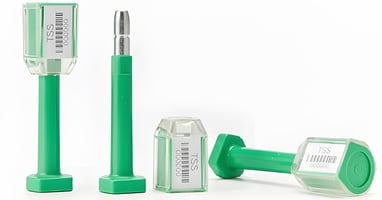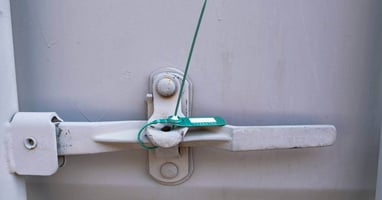When it comes to safeguarding your goods and maintaining trust, security seals are your first line...
Common Myths About Tamper-Evident Seals Debunked

Tamper-evident seals safeguard products during transportation to guarantee their authenticity upon arrival at their destination. However, despite their widespread use, many misconceptions exist about their functions and reliability. It’s important to debunk the common myths about tamper-evident seals. Here’s the information you need to know to make the most out of these powerful security tools.
Myth 1: Tamper-Evident Seals Are the Same as Tamper-Resistant Seals
One of the most prevalent misconceptions is that tamper-evident and tamper-resistant seals are the same thing. These two gadgets serve very different purposes.
The Truth
If a product’s packaging becomes altered in any way, tamper-evident or tamper-proof seals will visibly show signs of tampering. Examples include broken seals, void labels, and discoloration. The purpose of these seals is not to prevent tampering, but instead to make sure customers or handlers notice interference with shipments immediately.
Tamper-resistant seals, on the other hand, physically prevent or delay unauthorized access. Think of steel bolts used on shipping containers; these components make it more difficult to open a product without the proper tools or permissions. While tamper-resistant seals can have tamper-evident features, their strength is the primary deterrent.
Why It Matters
Confusing these terms puts you at risk of choosing the wrong tool for shipping products without tampering. If your focus is safety during transport, tamper-resistant seals are appropriate. To prioritize the consumers’ confidence in your products, tamper-evident seals are the best choice.
Myth 2: Tamper-Evident Seals Are Too Expensive
For businesses producing goods in large volumes, cost is a major concern. Some businesses believe that incorporating tamper-evident seals adds unnecessary costs to operations.
The Truth
Modern technology makes tamper-evident seals affordable. Solutions like custom labels or security-printed tapes cost less than a cent per unit when ordered in bulk.
Additionally, these seals are an investment in protecting your products and brand reputation. Implementing security seals is a choice that will support your business’s long-term success.
Why It Matters
The costs of neglecting tamper-evident measures can far outweigh their purchase prices. A single tampering incident, whether intentional or accidental, could lead to costly product recalls, lawsuits, or public relations crises.
For example, imagine you manage a farm-to-table agriculture business. To protect your brand image and comply with safety regulations, you must secure the goods from the point of harvest to the customer’s table. If the food is unsafe due to tampering, the situation will drastically diminish your brand’s value.

Myth 3: All Tamper-Evident Seals Are the Same
Unfortunately, some people believe a one-size-fits-all solution will accommodate every scenario. When you picture tamper-evident seals, you might think of generic solutions like shrink bands on jars or security stickers on electronics. There’s much more to uncover.
The Truth
Tamper-evident seals are customizable. Depending on your industry and product type, there are labels, tapes, holographic seals, and adhesives available. Advanced options even include serialized or QR-coded seals that allow you to track products throughout the supply chain.
The seals’ customization doesn’t stop at their functionality; they can also reinforce your branding. Many manufacturers choose seals printed with their logo or brand colors as an additional layer of security and customer recognition.
Why It Matters
The effectiveness of a tamper-evident solution depends on aligning the right seal with the right application. For example:
- Pharmaceuticals require seals compliant with regulatory guidelines and anti-counterfeit features.
- Perishable goods benefit from seals with temperature-sensitivity functions to discourage spoilage.
- Consumer electronics might use seals with permanent damage, like void tape, to prevent returning opened goods.
Myth 4: Tamper-Evident Seals Are Only Necessary for Valuable Products
You may think tamper-roof seals are only necessary for luxury goods or premium products where tampering could lead to significant financial loss. This myth leads to numerous businesses overlooking the importance of security seals.
The Truth
Tamper-evident seals are critical, even for everyday products. Packaging for food and beverages, household products, agricultural chemicals, and even certain types of clothing curations rely on security seals to demonstrate the integrity of their contents.
Why It Matters
Regardless of price, tampering poses functional and reputational risks. If customers notice a tampered label—even on an inexpensive product—they may lose trust in your brand entirely.
For example, if you’re shipping agricultural pesticides or seeds, tamper-evident seals guarantee the product has remained untouched. This guarantees farmers can use it safely. Remember, losing a customer’s trust can cost you in the long run.
Myth 5: Tamper-Evident Seals Can’t Adapt to New Technology
With so much buzz around advanced security solutions like blockchain and biometric authentication, some businesses mistakenly think tamper-evident seals can’t keep up with modern systems.
The Truth
Due to modern innovations, tamper-evident solutions integrate seamlessly with advanced, modern technology. Many seals feature serial numbers, QR codes, and RFID tags to complement digital product tracking tools.
Additionally, smart seals offer event-triggered notifications. If there’s a broken seal, these systems send alerts to manufacturers or business managers to provide a timely response.
Why It Matters
Modern tamper-evident seals bridge the gap between traditional physical security and digital innovation. If you choose to incorporate high-tech sealing options into your operations, you may gain a competitive advantage by appealing to tech-savvy partners and end-users alike.

Myth 6: Tamper-Evident Seals Are Too Easy To Remove
Another myth is that tamper-evident seals lack durability. When people assume that determined individuals will still bypass security seals unnoticed or reapply them without detection, they aren’t using tamper-evident seals to their full capabilities.
The Truth
High-quality tamper-evident seals explicitly prevent their removal without visible signs. Some of these methods include:
- Leaving behind residue when peeled off.
- A piece of void tape that reveals a permanent “void” pattern upon tampering.
- Safety labels that self-destruct, breaking into fragments upon a removal attempt.
No matter how skilled the person attempting to tamper with a product may be, these innovative designs ensure that unauthorized tampering is obvious.
Why It Matters
For organizations shipping sensitive or regulated goods, durability and reliability are non-negotiable. By choosing seals from reputable providers, you eliminate vulnerabilities and reassure both customers and regulators that your products meet compliance standards.
Increase Security and Trust in Your Brand
Misconceptions about tamper-evident seals can hinder your ability to optimize product security and customer trust. By understanding and debunking these common myths about tamper-evident seals, you’re much better prepared to choose solutions tailored to your specific manufacturing, distribution, or packaging needs.
The choice you make today could be the one that solidifies your reputation and protects your products tomorrow. Visit Logimate’s website to explore our tamper-evident solutions today!




